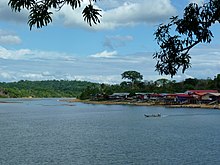Squatting in Suriname is the occupation of unused land or derelict buildings without the permission of the owner. Maroons and indigenous peoples such as Tiriyó Amerindians have squatted buildings and illegal gold prospectors have occupied land.


History
editSuriname became an independent republic in 1975, after previously being a Dutch colony.[1] The Dutch had recognised the land rights of the coastal Amerindians since 1686, and land rights of the various maroon groups from 1760 onwards.[2] In 1815, following the ratification of the Convention of London, Suriname became the only Dutch colony in the Guianas.[3]
In the 1990s, squatters occupied government-built housing at Koewarasan and called their occupation Sunny Point. The occupiers were mostly Maroons, who had been displaced by the Surinamese Interior War.[4] The village of Pokigron was destroyed in the conflict and people ended up squatting in a barracks near Paramaribo.[5]
The Tiriyó Amerindians have a habit of squatting abandoned sites. People moved from Kwamalasamutu to Alalapadu in the 1970s, then Alalapadu was re-occupied from 1999 onwards. Derelict colonial-era buildings in Kuruni were also squatted.[6]: 32 In Amatopo, houses had been built for an abandoned bauxite mining project. The first two settlers moved into the unused buildings near the airstrip and a pilot chased them away. Asongo Alalaparu, the granman (paramount chief of the tribe), told them to return and build their houses next to the facilities which were already present.[7]
The presence of gold in the interior, has attracted garimpeiros (illegal gold prospectors) who come mainly from Brazil. They have founded Antonio do Brinco[8] and Villa Brazil among others.[9]
See also
editReferences
edit- ^ Bulkan, Janette (2009). "Indigenous Rights and Building a Social Contract in the circum-Caribbean territories of Belize, Guyana and Suriname". In Aje, Lawrence; Lacroix, Thomas; Misrahi-Barak, Judith (eds.). Re-Imagining the Guyanas. Horizons anglophones. Montpellier: Presses universitaires de la Méditerranée. pp. 137–156. ISBN 9782367813639.
- ^ Scholtens, Ben (1994). Bosneger en overheid in Suriname. Radboud University Nijmegen (Thesis) (in Dutch). Paramaribo: Afdeling Cultuurstudies/Minov. pp. 19–22. ISBN 9991410155.
- ^ "Berbice". British Empire. Retrieved 7 August 2020.
- ^ Fat, Paul B. Tjon Sie (2009). Chinese New Migrants in Suriname: The Inevitability of Ethnic Performing. Amsterdam University Press. p. 156. ISBN 978-90-5629-598-1.
- ^ Vries, H. de (2 January 1991). "De ondergang van een Surinaams bosnegerdorp". Digibron (in Dutch). Retrieved 17 March 2021.
- ^ Heemskerk, Marieke; Delvoye, Katia (2007). Trio Baseline Study: A sustainable livelihoods perspective on the Trio Indigenous Peoples of South Suriname (PDF). Paramaribo: Stichting Amazon Conservation Team-Suriname.
- ^ Mans, Jimmy (2012). Amotopoan trails: a recent archaeology of Trio movements. Leiden: Sidestone Press. p. 131. hdl:1887/19857. ISBN 978-90-8890-098-3.
- ^ Hoefte, Rosemarijn; Oostindie, Gert (2015). In and Out of Suriname (PDF). Caribbean Series 34. p. 76. ISBN 978-90-04-28011-3 – via OAPEN Library.
- ^ "Boldewijn: 'Grensprobleem moet prioriteit gesprekken zijn'". Dagblad De West (in Dutch). Retrieved 18 March 2021.
Further reading
edit- Verrest, Hebe (2014). "The Development of Paramaribo in the Second Half of the Century". Suriname in the Long Twentieth Century: Domination, Contestation, Globalization. Palgrave Macmillan US. pp. 159–185. doi:10.1057/9781137360137_8. ISBN 978-1-137-36013-7.